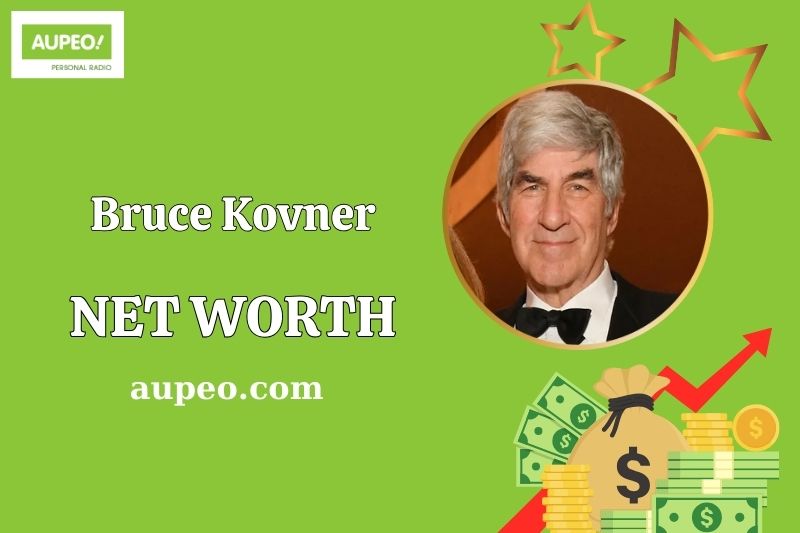Bruce Kovner is one of the most successful hedge fund managers in history. He founded Caxton Associates, a hedge fund known for its global macro trading strategies, and later established CAM Capital to manage his personal investments.
With decades of experience in finance, Kovner’s disciplined risk management and market analysis have made him a legendary figure in investment circles.
Beyond finance, he is also a major philanthropist, supporting education and the arts. His contributions to institutions like Juilliard School highlight his commitment to cultural and educational development.
In this article, Aupeo explores Bruce Kovner net worth, his financial strategies, and how he built his fortune.
Bruce Kovner Quick Facts

| FACT | DETAIL |
|---|---|
| Real Name | Bruce Stanley Kovner |
| Popular Name | Bruce Kovner |
| Birth Date | April 25, 1946 |
| Age | 78 (as of March 17, 2025) |
| Birthplace | Brooklyn, New York, USA |
| Nationality | American |
| Ethnicity | Jewish |
| Education | Harvard University, The Juilliard School, Harvard College, Van Nuys High School |
| Marital Status | Married |
| Spouse | Suzie Fairchild (m. 2007), Sarah Peter (m. 1973–1998) |
| Children | Three, including Rachel Kovner |
| Dating | N/A |
| Siblings | Three |
| Parents | Isidore Kovner, Sophie Kovner |
| Height | N/A |
| Net Worth | $8.6 billion |
| Source of Wealth | Hedge funds, Investments |
What is the Net Worth Of Bruce Kovner in 2025?

As of 2025, Bruce Kovner’s net worth is estimated at $8.6 billion. His fortune comes primarily from hedge fund management, notably through Caxton Associates, which he founded in 1983.
Over nearly three decades, the firm grew into one of the world’s most successful global macro hedge funds.
His wealth places him among the most financially successful investors, alongside other hedge fund titans like George Soros and Paul Tudor Jones. Unlike some billionaire investors who remain in the spotlight, Kovner has maintained a low public profile since retiring in 2011.
Related Financial Figures
- Caxton Associates
- CAM Capital
- Juilliard School
- American Enterprise Institute
- Goldman Sachs
- Success Academy Charter Schools
- Paul Tudor Jones
- Julian Robertson
- Ray Dalio
- David Tepper
Kovner’s financial standing also positions him among the most influential billionaires in finance, alongside other investment legends. Check out other financial powerhouses shaping today’s markets.
Bruce Kovner Wealth, Salary, and Financial Overview

How Did He Build His Wealth?
Bruce Kovner’s financial journey started in 1977 with a $3,000 credit card loan, which he invested in soybean futures. His first trade turned into $40,000 before fluctuating back to $23,000, teaching him an essential lesson in risk management.
He later joined Commodities Corporation, where he worked under Michael Marcus, learning advanced trading techniques. In 1983, he founded Caxton Associates, which became one of the most successful hedge funds, managing up to $14 billion in assets at its peak.
What Are the Key Factors Behind His Financial Success?
Kovner’s wealth grew due to several core principles:
- Global Macro Trading: Investing based on macroeconomic trends.
- Risk Management: Strictly controlling losses to protect capital.
- Long-Term Vision: Avoiding short-term speculation and focusing on sustainable returns.
- Disciplined Decision-Making: Using data-driven strategies rather than emotional reactions.
These methods helped Caxton Associates achieve an average annual return of 21% over 28 years.
How Did His Hedge Fund Generate High Returns?
Caxton Associates specialized in global macro trading, analyzing economic trends across currencies, interest rates, and commodities. Some key strategies included:
- Forex and Interest Rate Arbitrage
- Government Bond Trades
- Commodity Investments
- Stock Market Index Positions
By focusing on large-scale global economic shifts, Kovner capitalized on major financial trends while mitigating risks through strategic hedging.
What Role Does CAM Capital Play in His Financial Portfolio?
After retiring from Caxton Associates in 2011, Kovner founded CAM Capital in 2012. Unlike Caxton, which managed external client funds, CAM Capital focuses exclusively on managing his personal investments.
The firm invests in:
- Private equity
- Hedge funds
- Venture capital
- Real estate
How Does He Allocate His Wealth?
Kovner’s wealth is distributed across multiple sectors:
- Financial Markets: Investments in hedge funds, stocks, and commodities.
- Real Estate: High-end properties in New York, Florida, and California.
- Philanthropy: Major contributions to education and the arts.
His real estate holdings include a 22-acre oceanfront estate in Carpinteria, California, part of which was sold to Ellen DeGeneres and Portia de Rossi for $70 million.
What Is His Influence on the Financial Industry?
Kovner’s impact on finance goes beyond his personal fortune. He has:
- Shaped global macro trading through his strategies.
- Mentored top investors, including those who later managed major hedge funds.
- Contributed to financial policy discussions via the American Enterprise Institute.
His legacy continues to influence traders and investors worldwide.
What Are His Philanthropic and Educational Contributions?
Kovner has donated millions to Juilliard School, where he serves as chairman. His contributions include:
- $60 million to establish the Kovner Fellowship Program.
- $20 million to support historical music performance.
- A valuable collection of music manuscripts donated in 2006.
Beyond the arts, he has supported conservative think tanks like the American Enterprise Institute and educational initiatives like Success Academy Charter Schools.
Conclusion
Bruce Kovner’s financial success is built on disciplined trading, risk management, and strategic investments. While he has stepped away from hedge fund management, his influence remains strong in both finance and philanthropy.
Want to explore more billionaire success stories? Visit Aupeo for in-depth financial insights.

